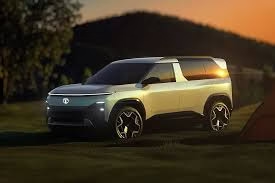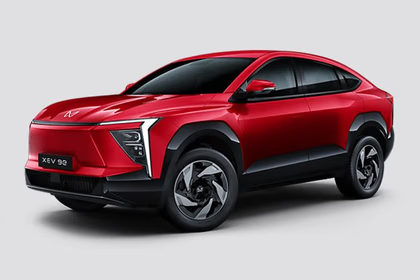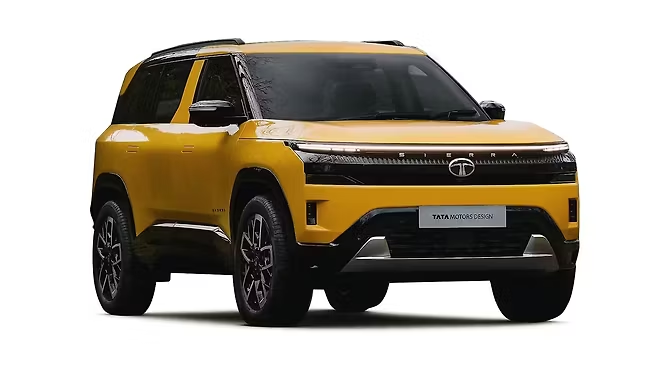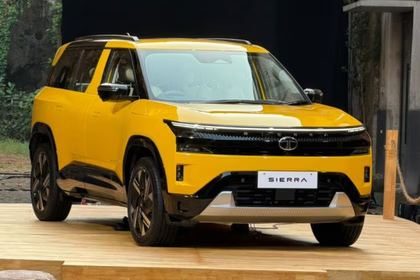Introduction
Tata Motors is not only part of India’s electric vehicle revolution — it’s spearheading it. With the Nexon EV and Tiago EV already dominating their respective segments, Tata has established itself as the EV trailblazer in Bharat. However, 2025 appears poised to be the most ambitious year yet for Tata Motors. Why? Because two beloved names of its past are returning — and this time, all-electric.
The Tata Harrier EV – an electric variant of the brand’s aggressive, highway-cruising SUV. Famous for its bullying stance, tough driving, and luxury sheen, the Harrier EV now offers all this with no emissions and state-of-the-art EV technology.
The Tata Sierra EV – a retro return like no other. A 90s icon by birth, the Sierra has been resurrected as a science fiction-inspired, concept-drawn electric SUV that combines retro sentiment with cutting-edge innovation. The instant it was launched at the Auto Expo, it ran through India’s EV world like adrenaline.

Now, both are set to launch in 2025, and car buyers want to know one thing:
Which one will dominate the roads – the flamboyant Harrier EV or the soulful Sierra EV?
Power vs personality? Futuristic nostalgia vs EV supremacy? Or is there a default winner in the minds of Indian EV buyers?
Let’s pit the battle to decide India’s premium EV SUV segment in 2025.
Design Showdown – Road Presence against Nostalgia
The Tata Harrier EV is a beast in its electric avatar. It takes the aggressive silhouette of the ICE Harrier and dyes it with an overdose of futuristic polish. The front grille is now closed and lit, the DRLs are angular, and the coupe-esque rear adds a sporty, EV-first persona. It’s designed to draw eyeballs on highways, with a layout that screams power, presence, and contemporary sensibilities.
The Tata Sierra EV – and suddenly, it gets emotional. It’s not an SUV; it’s a part of Indian automotive heritage reimagined for the future. The swooping rear glass, simple side profile, and subtle LED lights nod to the ’90s original. But inside, it’s a lounge on wheels – light, elegant, and almost Scandinavian in design. It’s not designed to own but to bond with memories. So, what excites the current EV buyer? The Harrier EV’s aggressive posture or the Sierra EV’s emotional retro-futurism?
Design Highlights: Harrier EV
- Aggressive and muscular SUV posture
- Sealed EV-style front grille with LED DRLs
- Aero-tuned alloys and coupe-like rear
- Elevated ground clearance for road dominance
- Dual-tone futuristic color scheme
Design Highlights: Sierra EV
- Retro-futuristic design with curved rear glass (iconic windowline)
- Clean, minimalist, and futuristic body language
- Lounge-inspired interior with white ambient hues
- Floating roof and long LED strip
- Concept-style alloy wheels and panoramic glass features
Powertrain & Range Comparison
The Harrier EV and Sierra EV are the heartbeat of Tata’s next-generation electric technology under the bold-looking hoods of the Ziptron Gen 2 platform. This isn’t an update; it’s a complete EV-first overhaul designed for more extended range, quicker charging, and potent performance.
The Tata Harrier EV. It’s already promised an all-wheel-drive configuration, probably driven by dual motors — one for each axle. That translates to improved traction, greater control on Indian roads, and torque output, making even a large SUV handle like a sprightly car. With Tata setting its sights on more than 500 km of real-world range, the Harrier EV is becoming a genuine intercity fighter.
The Tata Sierra EV is also positioned as a city-to-weekend tourer. Official specs remain under wraps for now, but initial concepts indicate a rear-wheel-drive configuration emphasizing balance, comfort, and efficiency in range. The Sierra isn’t about raw power — it’s about the serene confidence of cruising, whether on city streets or a weekend drive out into the countryside.
Yes, both EVs should have DC fast charging capability, as well as sophisticated tech such as Vehicle-to-Load (V2L) and even Vehicle-to-Vehicle (V2V) charging, so you can charge devices or even assist in charging another EV on the move.
Anticipated Powertrain Specifications
Tata Harrier EV
- Ziptron Generation 2 platform
- Dual-motor configuration (AWD confirmed)
- Estimated 0-100 km/h under 9 seconds
- Real-world range: 500–550 km
- Sophisticated high-performance cooling and regenerative braking system
Tata Sierra EV
- Ziptron Gen 2 platform
- Single motor (Likely Rear-wheel drive)
- Smooth torque delivery, urban drivability focus
- Real-world range: 500+ km
- Optimized for city + leisure touring balance
Charging & Energy Features (Both)
- DC fast charging support (up to 150 kW expected)
- 10–80% charge in ~40 minutes (est.)
- AC home charging with wallbox (7.2 kW / 11 kW)
- V2L (Vehicle-to-Load) – power appliances off your EV
- V2V (Vehicle-to-Vehicle) – charge another EV while on the move
Dimensions, Boot Space & Seating
Electric SUVs are not just about size — it’s about how you live. Whether filling up luggage for a family holiday or navigating narrow city streets, your EV’s dimensions make all the difference.
The Tata Harrier EV inherits the full-size SUV DNA. Broad by nature, with a long wheelbase and high ground clearance, it’s built for rough roads, road travel, and ample space. It’s a proper 5-seater, and initial teasers indicate that boot space is still plentiful even with the battery onboard.
The Tata Sierra EV, nevertheless, adopts a wiser footprint. It is approximately 4.3 metres long, placing it in the premium crossover segment. Nonetheless, owing to innovative design and Tata’s Sigma platform tweaks, the Sierra has surprisingly spacious interiors, particularly in the lounge-style setup previewed at the Auto Expo. Tata is also looking into two seating configurations: a 5-seater and a potential 7-seater setup for families.
Where the Harrier EV yells ‘adventure SUV’, the Sierra EV murmurs’ urban luxury with a twist’ — slight enough for towns, yet roomy enough for weekend getaways.
Tata Harrier EV – Dimensions & Seating
- Length: ~4.6+ meters (judging by ICE Harrier)
- Seating: 5-seater with generous rear bench
- Boot Space: ~450–475 litres (estimated, with flat floor)
- Ground Clearance: High, off-road capable
- Wider stance, improved highway stability
Tata Sierra EV – Dimensions & Seating
- Length: ~4.3 meters (urban crossover class)
- Seating: 5-seater confirmed, 7-seater optional? (speculative)
- Boot Space: ~400 litres (with innovative layout)
- Lounge-inspired layout with panoramic visibility
- Designed for tight parking & nimble city driving
Features & Tech War – Intelligent, Safe & Chic
Tata Harrier EV and Tata Sierra EV are set to arrive chock-full of next-generation technology that dissolves the boundary between mobility and smart mobility. From cutting-edge safety systems to immersive infotainment, Tata is all-in on tech — and the war is heating up.
On the same page, both SUVs are expected to come equipped with Tata’s Gen 2 ADAS suite, including lane assist, adaptive cruise control, emergency braking, etc. A 360° surround view camera, 12.3-inch touchscreen infotainment, completely digital instrument cluster, and Tata EV’s new user interface will promise a connected, responsive ride.
Here’s where the differences begin.
The Tata Sierra EV shoots for the lifestyle-first, lounge-on-wheels vibe, sticking to its concept DNA. It’s been hinted at with a huge panoramic sunroof, a serene white interior theme, and a cabin design that prioritizes comfort, minimalism, and serenity. Tesla, but with an Indian heart.
The Tata Harrier EV, however, is likely to keep its tough, functional dashboard, but with EV-oriented updates — lit bits, digital switches, and a sporty look. It’s about power and purpose, not Zen. And yes — both SUVs will have OTA (Over-The-Air) updates, voice assistants, remote diagnostics, geo-fencing, and complete smartphone connectivity.
Smart Features (Expected)
- ADAS Gen 2 with advanced driver assist features
- 12.3″ infotainment touchscreen + digital driver display
- 360° surround view camera with blind spot assist
- Connected Car Suite via Tata.ev app
- OTA updates, voice command, wireless Apple CarPlay/Android Auto
- Drive modes + regen braking control
Tata Sierra EV Unique Tech Highlights
- Panoramic glass roof with lounge-light ambiance
- White, minimalist cabin with a floating dashboard
- Rotating front seats (concept-only for now)
- Mood lighting and ambient experience
Tata Harrier EV Unique Tech Highlights
- Robust, SUV-type dashboard with EV upgrade features
- Sporty dual-tone interiors with blue/grey sports-style accents
- Glowing Tata emblem, space-age gearshift
- Off-road drive modes + terrain assist (anticipated AWD variant)
Safety & Build Quality
Tata Motors leaves no stone unturned — and neither will its future-generation electric SUVs. Both the Tata Harrier EV and Tata Sierra EV are set to uphold Tata’s commitment to manufacturing India’s safest passenger cars, now with an electric makeover.
- At the core of their safety lies architecture.
The Tata Harrier EV is founded on the extensively reworked OmegaArc platform, derived from the iconic Land Rover D8. But this platform has been seriously beefed up for the electric conversion to support the battery pack without sacrificing crash integrity and high torsional stiffness. Look forward to an even more rigid, stronger frame than the ICE model.
The Tata Sierra EV will be the first to adopt Tata’s dedicated Sigma EV architecture — a born-electric derivative of the ALFA platform. This promises improved weight distribution, a low center of gravity, and a cabin prioritizing safety-first principles such as crumple zones, isolated battery protection, and frontal crash absorption. Both SUVs are anticipated to score a 5-star GNCAP safety rating, taking cues from Nexon, Punch, and Tiago EV — all of which have set segment benchmarks.
Common Safety Expectations
- Based on Tata’s high-strength steel platforms (OmegaArc / Sigma EV)
- Anticipated 5-star GNCAP crash test rating
- Fire & impact-proof reinforced battery housing
- Electronic Stability Control (ESC), Hill Hold, Traction Control
- ADAS Gen 2 with collision avoidance, blind spot detection
- 6 Airbags standard (probable)
Tata Harrier EV – Structural Safety Notes
- OmegaArc adapted for EV duty (ICE-to-EV conversion)
- Underbody shielding for the battery
- Increased ground clearance aids in undercarriage impact
- Enhanced torsional rigidity for hard-duty road use
Tata Sierra EV – Structural Safety Notes
- Sigma EV: Born-electric platform for enhanced safety packaging
- Optimized crumple zones & cell-level battery protection
- Reduced center of gravity = improved rollover protection
- Inflated idea cabin configuration for frontal collision protection
Price Expectation & Launch Timeline
Tata’s twin EV powerhouses — Harrier EV and Sierra EV — are not just electrifying the market with their design and tech, they’re also drawing massive anticipation over one critical factor: Price.
In a segment where top-end EVs frequently breach Rs 40–50 lakh, Tata is looking to turn the rulebook on its head by pricing high-range electric SUVs below Rs 35 lakh, making them aspirational but affordable to India’s emerging class of EV-smart buyers.
Tata Harrier EV: With an established dual-motor AWD configuration, bigger size, and high-end tech stack, the Harrier EV should debut in the Rs 28–32 lakh price segment (ex-showroom). As per year-end EV launch plans, Tata has indicated a late 2025 launch, perhaps towards the festive season.
Tata Sierra EV: The Sierra EV is filled with emotional value and future looks, it will cost marginally less because it has a smaller footprint and rear-wheel drive configuration. Projected range: Rs 25–30 lakh (ex-showroom). Launch might occur sooner, mid to Q3 of 2025, becoming the first of the two to reach the roads.
Subsidy & Financing Advantage
The EVs should qualify for FAME 2 incentives, as long as the scheme is renewed or replaced in the expected FAME III policy. Most Indian states, such as Maharashtra, Delhi, and Tamil Nadu, also have state-level incentives and road tax concessions, which can reduce the on-road price by Rs 1–2 lakh based on the location.
Tata’s partnership with Tata Motors Finance and Tata Power will also ease the bundling of charging, insurance, and loan schemes in a single EMI — another advantage for mass EV adoption.
Expected Price & Launch Summary
| EV Model | Expected Price (Ex-showroom) | Launch Timeline | FAME/State Subsidy |
| Tata Harrier EV | Rs 28–32 lakh | Late 2025 (Festive) | Yes (likely) |
| Tata Sierra EV | Rs 25–30 lakh | Mid-to-Late 2025 | Yes (likely) |
Target Audience & Use Case
The Tata Harrier EV and the Tata Sierra EV, it’s not just a matter of specs — it’s a lifestyle choice. All SUVs have been conceptualized with a specific type of Indian EV buyer.
The Harrier EV is designed for those who enjoy living in the fast lane — highway enthusiasts, adventure drivers, and long-distance commuters. It comes equipped with dual-motor AWD, strong stance, and increased ground clearance to conquer expressways, weekend trips, and even uncertain terrains. It is the ideal EV for family travel enthusiasts or professionals requiring dependable intercity mobility with power and comfort.
The Tata Sierra EV, meanwhile, is for the urban explorers, design-first thinkers, and nostalgia lovers. It’s sleek, emotionally resonant, and perfect for people who want a premium, futuristic SUV for city life, occasional touring, and standing out in traffic. Whether you’re a tech-savvy early adopter or grew up loving the original Sierra, this one speaks to the heart.
Harrier EV vs Sierra EV – Use Case Comparison
| Feature / Factor | Tata Harrier EV | Tata Sierra EV |
| Ideal For | Highway commuters, adventure seekers | Urban EV buyers, premium lifestyle users |
| Drive Type | AWD (Dual Motor) – for performance & terrain | RWD (Single Motor) – efficient & smooth drive |
| Range Focus | Long-distance, intercity comfort | Balanced – city + short touring |
| Design Appeal | Bold, rugged, sporty | Futuristic, minimal, nostalgic |
| Interior Vibe | Sporty, SUV-centric cabin | Lounge-style, relaxed premium cabin |
| City Drive Comfort | Wide SUV – manageable in big cities | Compact crossover – highly urban-friendly |
| Who Will Love It Most? | Families, professionals, road-trippers | Creatives, techies, retro lovers, couples |
Final Verdict – 2025’s Most Anticipated EV SUV?
The Tata Sierra EV has won India’s heart with hype and emotional hype. Reimagined with a futuristic spin, the revival of a 90s legend has generated nostalgia that crosses generations. Its Auto Expo unveiling turned into a viral sensation, and initial reactions indicate that it’s one of the most emotionally anticipated EVs in the history of Indian automobiles.
But when it comes to utility, powertrain confidence, and long-range usability, the Tata Harrier EV gains. It targets buyers seeking reliability, brawn, and road presence in an electric guise by leveraging its tried-and-tested OmegaArc DNA, dual-motor AWD power, and Tata’s EV maturity.
So, who is the winner?
- The Sierra EV wins hearts with design, emotion, and lifestyle appeal.
- The Harrier EV wins hearts with features, range, and weather-beating versatility.
- Ultimately, the “most anticipated EV SUV of 2025” is up to you:
- If you’re an emotional, style-conscious city shopper, the Sierra EV is beckoning your name.
- If you’re a practical, performance-focused SUV enthusiast, the Harrier EV is your destiny.
FAQs
Q1. Will there be a 4×4 variant for the Tata Sierra EV?
So far, Tata has not officially announced a 4×4 version of the Sierra EV. It is likely to come with a rear-wheel drive configuration first. However, given the brand’s concept heritage and off-road DNA, a dual-motor AWD version might follow later, based on customer demand.
Q2. Can I pre-book a Harrier EV online?
Pre-bookings for the Tata Harrier EV haven’t gone live as of mid-2025. Tata Motors will open an online booking window before the festive season. Watch this space on Tata EV and official dealerships’ websites for updates.
Q3. Will they be eligible for subsidies under PM-eBus or FAME III?
Though the PM-eBus program deals with public electric buses, Harrier EV and Sierra EV would likely be eligible under FAME II (assuming extended) or the upcoming FAME III policy. Moreover, state-level incentives for EVs (such as in Delhi, Maharashtra, Telangana, etc.) may provide on-road cost savings of Rs 1–2 lakh based on where you are.
Q4. Can I have a home fast charger for Harrier/Sierra EV?
Yes, Tata will provide exclusive home charging solutions with both models. You can get a 7.2 kW or an 11 kW AC fast charger through Tata Power EV Charging Solutions, which is included at the time of purchase. With this installation, you can charge your SUV overnight and have a 100% battery in the morning.




